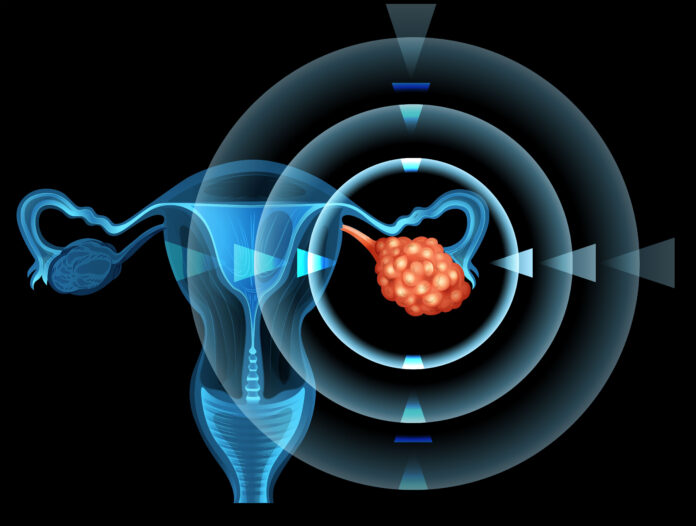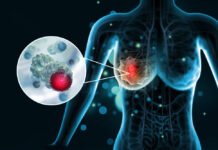
Among the most significant causes of mortality and morbidity worldwide is cancer. Primarily, cancer complications are characterized by uncontrolled and continuous cell proliferation and spreading into the surrounding tissues. Notably, ovarian cancer is currently leading to traumatizing women’s reproductive health. It is worth noting that ovarian cancer comprises multiple diseased conditions of the ovaries. Sundry types of ovarian cancer exist depending on the morphology under the microscope and their treatment and prognosis. Ovarian cancer is usually mistaken for other common problems due to its subtle nature. In most cases, ovarian cancer only shows symptoms at an advanced stage. However, the signs and symptoms of various ovarian cancer exhibit similar properties. Ovarian tumors should never be confused with ovarian cysts. While ovarian tumors are solid masses, ovarian cysts are usually fluid-filled.
Notably, sundry risk factors are considered the root of ovarian cancer. A kinfolk’s past of ovarian cancer is among the significant menace factors associated with the onset of ovarian cancer. The reason behind the risk of family history is tied to hereditary issues. Although it is assumed to account for a smaller percentage of females with ovarian malignancy, it has to be considered a vital risk factor. Markedly, a family history of uterine, rectal, colon, breast, and ovarian cancers indicate an increased risk to the progenies. Even though no genetic mutation is diagnosed in those patients, the increased risk of ovarian cancer still prevails. Besides, personal history of cancer or even endometriosis indicates an increased risk of ovarian cancer.
Moreover, genetic mutations on genes linked with ovarian cancer, such as the BRCA2 and BRCA1, culminate into ovarian cancer. Thus, genetic mutations are among the fundamental causes of ovarian cancer. Most of the time, the modifications in breast cancers 1 and 2 are hereditary. Besides, they are linked to both breast and ovarian cancer, thus increasing the possibility of ovarian cancer. Furthermore, the hereditary nonpolyposis colorectal cancer (HNPCC) genetic syndrome is also genetically linked to ovarian cancer. About 12% of women with HNPCC have an increased menace of having ovarian cancer. Additionally, even though women are at a possibility of having ovarian tumors at any age, aged women account for a higher percentage among those with ovarian cancer. Moreover, the remedy for menopausal women, hormone replacement therapy, is linked to a proliferated possibility of having ovarian tumors, especially in females who have not undergone a hysterectomy.
Ovarian cancer is observed to have several stages. Stage 1 ovarian cancer has an excellent established prognosis. Stages 1A and 1B survival rate is five years for 90% of patients with grade 1 tumors. Hysterectomy is considered the perfect treatment for stage 1 ovarian cancer, where both ovaries and the fallopian tubes are removed. Depending on the pathologist’s interpretation, further treatment may be unnecessary if the tumor is low-grade. However, combination chemotherapy may be necessary when the cancer is high-grade. Stage 2 ovarian cancer implies that cancer has already spread to single or two ovaries and has disseminated to most organs within the pelvis. Stage 2A ovarian cancer is when the tumor has disseminated to the oviduct and uterus. When cancer has penetrated the tissues of the pelvis, the phase is denoted as stage 2B. Under phase 2C, cancer has already spread to other tissues within the pelvis and the uterus. Besides, the fallopian tubes are at this stage where the cancer cells may be found in the peritoneal opening. About 70% of victims at this stage have a five-year survival rate. Bilateral salpingo-oophorectomy and hysterectomy are surgical procedures for patients in stage 2. Besides, combination chemotherapy with or without radiation therapy may be the recommended treatment after the surgical procedure.
Stage 3 ovarian cancer implies that cancer has disseminated to single or two ovaries around the pelvis and has entered parts of the stomach and around the lymph protuberances. In phase 3A, cancer is only found within the pelvis region and can be microscopically seen within the peritoneum tissues. Under stage 3B, the tumor has disseminated to the peritoneum, and the growth is about 2cm long or even lesser. Under phase 3C, cancer within the peritoneum is more significant than 2cm and has spread to the lymph nodes. About 39% of patients with ovarian cancer have a five-year survival rate. The preferred surgical procedures are hysterectomy, salpingo-oophorectomy, and debulking of tumors around the lymph nodes, pelvis, and abdomen. Combination chemotherapy followed by additional surgery is recommended. Phase 4 ovarian growth implies that cancer has moved outside the stomach to various body parts such as the lungs or liver. The survival rate is meager, and only 17% of patients have a five-year survival rate. Surgical removal of the cancerous tissues as much as possible, coupled with combination chemotherapy, is the recommended remedy.
Remarkably, ovarian cancer treatment involves local and systemic therapies. The treatment regarded as local therapy includes treating the tumor without affecting other body parts. The respective local ovarian cancer therapies are radiation therapy and surgery for ovarian cancer. Surgery for ovarian cancer is the primary treatment preferred in cancer management. The surgery depends on the extent the cancer has spread and the body’s health. Women who can bear children with tumors and cancer in the early stage are treated without removing the ovaries and uterus. Again, there are two main goals in epithelial ovarian cancer surgery, debulking, and staging. Surgery is not appropriate when cancer is not staged and debulked. Staging epithelial ovarian cancer is necessary to observe cancer spreading from the ovary. Removal of the uterus is called hysterectomy; removing fallopian tubes and both ovaries is called bilateral salpingo-oophorectomy (BSO). Usually, the operation involves the removal of the omentum and a process called an omentectomy. Sometimes, cancer spreads to the omentum, an area covering abdominal contents.
Moreover, debulking epithelial ovarian cancer forms another critical goal of ovarian cancer surgery, which aims to remove many tumors leaving no visible tumors. Debulking is more important upon spreading ovarian cancer in the abdomen when performing surgery. Patients with optimally debulked tumors exhibit a better prognosis than those with larger tumors during surgery. Surgery sometimes aims to remove cancer in ovarian stromal and germ cell tumors. Bilateral salpingo-oophorectomy and hysterectomy are used in treating most ovarian tumors. If cancer is in one ovary and one wants to bear children, treatment would involve removing the ovary and fallopian tube containing cancer. More tissues must be removed when cancer has spread everywhere in the ovary, requiring bilateral salpingo-oophorectomy, hysterectomy, and debulking surgery.
Markedly, systemic therapy encompasses drug usage in treating ovarian cancer. The drugs used are known as systemic therapies because of their ability to reach cancer cells in the entire body. The drugs are administered directly into the bloodstream or can be given orally. Based on ovarian cancer, drug treatment may compose hormone therapy, chemotherapy, or targeted therapy for ovarian cancer. Noticeably, hormone-blocking drugs or hormones are critical agents in hormone therapy; they fight cancer. The rarely systemic remedy is employed to cure epithelial ovarian tumors and is frequently used in ovarian stromal cancer treatment. Mainly, Luteinizing-hormone-releasing hormone (LHRH) agonists are an example of drugs useful in cancer treatment; they lower estrogen levels in premenopausal women. Such drugs include leuprolide and goserelin. The LHRH agonists are given through injection every one to three months. Some of its side effects are symptoms of menopause, like vaginal dryness and hot flashes. If taken for an extended period, the drugs can cause osteoporosis.
Another drug in this category is Tamoxifen, often used in breast cancer treatment. Also, it is helpful in ovarian stromal tumor treatment and rarely in the control of progressive epithelial ovarian tumors. Tamoxifen functions as an anti-estrogen in several bodies are s. Tamoxifen therapy keeps estrogens circulating in a woman’s womb from exciting growths. Similarly, Aromatase inhibitors are drugs under the LHRH category that block an aromatase enzyme activity, turning other hormones into estrogen when a woman is in post-menopause. The drugs help lower women’s estrogen levels after menopause. Mainly, the drugs treat breast cancer and ovarian stromal tumors recurring after treatment. The drugs are taken once per day as pills.
Furthermore, chemotherapy is another systemic treatment in which drugs are used to treat cancer. In this form, drugs directly enter the bloodstream in all body parts. Chemo helps kill or shrink small amounts of cancer cells found after surgery, primarily cancers that have spread. Chemo is applied through injection, given orally or via catheter, directly injected into the abdominal cavity through intraperitoneal chemotherapy. Two different drugs are used together in chemotherapy for ovarian cancer. The combined drugs include a platinum compound, carboplatin or cisplatin, and a chemo drug called taxanes like paclitaxel or docetaxel. Usually, epithelial ovarian cancer shrinks with chemo, but cancer cells grow again after some time. After applying the first chemo and no noticeable change is seen for six to twelve months, the same chemotherapy used for the first time should be used in treatment. Intraperitoneal chemotherapy is given in addition to systemic therapy in treating cancer that has not spread nor debulked. Ovarian stromal tumors are not treated with chemotherapy; they are treated with a combination of paclitaxel and carboplatin. Losing appetite, hair loss, queasiness, spewing, mouth lesions, and foot and hand rashes are among the side effects of the chemotherapies.
Additionally, targeted therapy in ovarian cancer employs drugs helpful in identifying and attacking cancer cells and having less effect on normal or healthy cells. Targeted therapy operates differently in each administration, affecting the growth of cancer cells, the division and repair process, and their interaction with other cells. Bevacizumab, a drug type, belongs to the angiogenesis inhibitors class. The drug attaches to vascular endothelial growth factor (VEGF), a protein that signals new blood vessel formation to slow or stop cancer growth. Bevacizumab shrinks or slows advanced epithelial growths associated with ovarian cancers. Bevacizumab works better with chemotherapy and can also be given with Olaparib. The side effects of bevacizumab include headaches, hypertension, low white blood cells (WBCs), tiredness, and bleeding. Other drugs useful in ovarian cancer treatment are polyadenosine diphosphate-ribose polymerase (PARP) inhibitors, including rucaparib, Olaparib, and niraparib. Such drugs are known to slow or shrink advanced ovarian cancers in time; they are thought to increase women’s life span.
Conclusively, it is noted that progress has been established in comprehending ovarian cancer over the preceding eras. Although much persists unlearned, for instance, the origin of ovarian cancer, its mechanism of development, essential knowledge for its prevention, and improved treatment. Effective communication is required in the early recognition of ovarian cancer and managing wide ovarian cancer varieties. More effective approaches should be encouraged to ensure self-management and supportive care among women with ovarian cancer.















